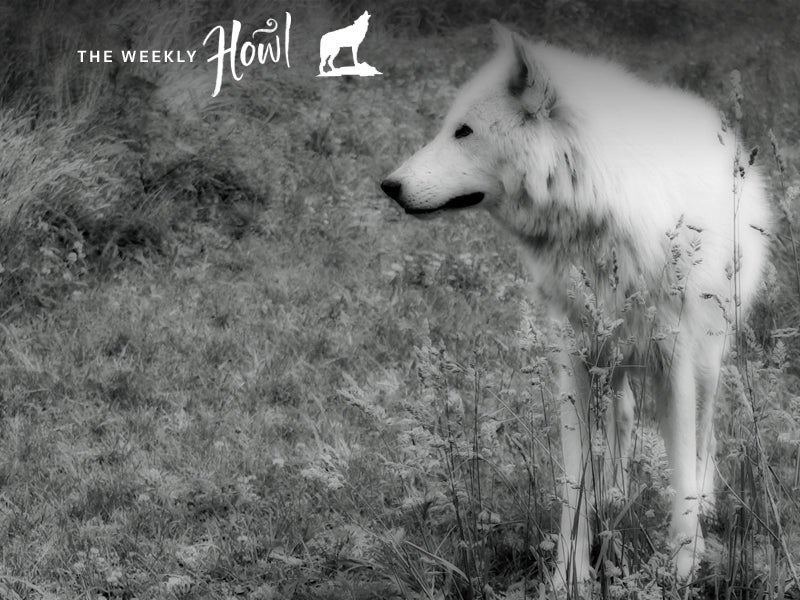Wolfdog Rescue Brings a Misunderstood Breed Out of the Shadows
At Howling Woods Farm wolfdogs of all stripes educate the public about wolf lore and management, and a lucky few find new adoptive homes.

This page was published 10 years ago. Find the latest on Earthjustice’s work.
His name was Ahote (American Hopi for “the restless one”). He was a mix of eastern timber and Arctic wolf. Although he was bottle fed as a puppy and quite comfortable around humans, his wolfy nature showed itself at around a year of age when he became more aware of his surroundings and suspicious of strangers. His pack included three others—Takoda, Sierra and Bandit. The four lived alongside other packs at Howling Woods Farm in the New Jersey Pinelands, 70 miles outside of New York City as the crow flies.
Ahote was a wolfdog. Not directly the product of dogs and wolves (pure wolves haven’t been bred legally in the United States since the 1960s), he was a wolf/dog hybrid, the product of those unions over time. Wolfdogs are highly intelligent, social and energetic, and they require lots of training and socialization.
Eight months ago, members of Howling Woods Farms’ all-volunteer staff noticed Ahote limping. They took him to the vet and an X-ray confirmed the worst—fast-moving bone cancer had developed in his leg and likely metastasized to his lungs. The staff quickly decided to amputate his leg to ease his pain.
Ahote stayed at a volunteer’s house during the first two months of his rehabilitation. After a while, Howling Woods staff brought Takoda, Sierra and Bandit over for company. Through the tender loving care of the staff and a bone and raw food diet, Ahote regained strength every day, but concerns grew about his reentry into his pack at the farm. How would this visibly weakened, three-legged wolfdog be received?
Howling Woods Farm facilitates wolf education and wolfdog rescue. The farm, one of the few wolfdog rescues in the United States, adopts 8 to 12 wolfdogs to private homes every year. Eight “ambassador animals” remain at the farm permanently and participate in various educational activities.
The farm’s primary goal is to provide education about the true nature of wolves. The farm’s wolfdogs meet hundreds of people weekly through visits to schools, libraries, senior centers and scout camps, as well as private appointments at the farm. Howling Woods Farms’ message includes discussion about the place of wolves in history and culture, as well as current wolf management policies, including efforts to remove wolves from the Endangered Species list.
Like their wild relatives, wolfdogs are stigmatized. Seventy five percent of purchased pups don’t make it in a home setting, and even a dog with no wolf pedigree that has been labeled a “wolfdog” is at risk of early euthanasia. For this reason, Howling Woods Farm shelters and adopts out large dogs as well. There is no breed standard for wolfdogs, and content is determined through phenotyping—the close examination of the animal’s physical and behavioral characteristics, from leg and muzzle length to timidity. The wolfdog is then categorized from “no-content” to “high-content” wolf.
Wolves are naturally timid around humans. A high-content wolf dog is more timid around people than a dog with no wolf content at all. However, the breeding of wolfdogs is highly under-regulated. Unscrupulous breeders often mislead, assigning “high-content” status to a pure bred Malamute in order to obtain a higher fee. On the other hand, true high-content wolfdogs are sometimes sold to people who live in city apartments or condominiums.
It’s not easy to adopt a wolfdog from Howling Woods Farm. The Farm’s screening process is thorough, and 19 out of 20 applicants for adoption are turned down, often because their homes lack outdoor enclosures, they do not have another dog present for companionship or a potential companion animal is not compatible. Most of the animals the farm shelters have been abandoned by unprepared owners. Often, when an animal reaches six months (“when they’re large enough to cause destruction,” says Hodanish) they’re let go, only to be picked up by animal control and euthanized.
The farm is equally selective when entertaining offers from movie studios and other media. Because of wolves’ negative portrayal in the media, Hodanish and his team turn down 75 percent of all media offers. When Howling Woods Farm wolfdogs do appear in Vogue or a film like Disney’s “The Sorcerer’s Apprentice,” they are handled onsite by Howling Woods Farm staff.
And what about Ahote? Once an alpha, always an alpha. Ahote returned to his pack resilient, brave and dignified, and the pack never once challenged him. He had another few months full of play—he even became an adoptive father to two new pups—before he succumbed to his illness.
Neither Howling Woods Farm nor Earthjustice supports the breeding of wolfdogs. To learn more about Ahote’s story, watch this short video. Visit the Howling Woods Farm website for more information. And if you’re thinking about adopting a wolfdog, check out this article on thebark.com.
About this series
2015 marks the 20th anniversary of the reintroduction of gray wolves to the northern Rockies, and since that time wolves have been under nearly constant threat of losing their protections. The Weekly Howl provides insights and education about the gray wolf and updates on the status of its protections while celebrating the iconic species as a vital part of a functioning, healthy ecosystem. Posts will appear every Wednesday starting June 17 and running through the summer.
Don’t miss last week’s post: Understanding the Big, Bad Wolf: Using Art to Celebrate and Demystify a Polarizing Animal.